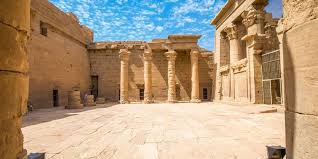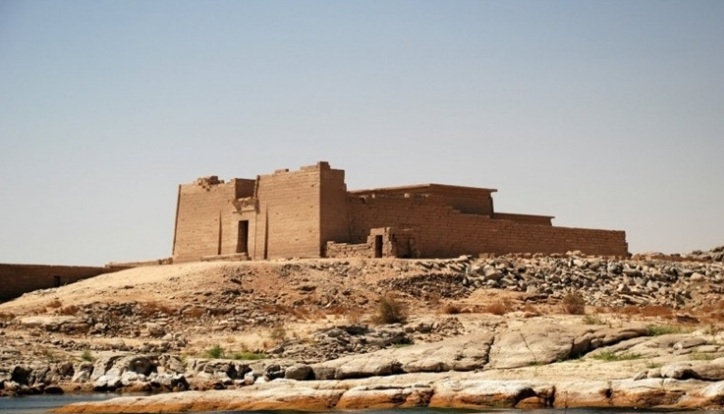Kalabsha Temple, also known as the Temple of Mandulis, is one of the most impressive ancient monuments in Nubia, located today near Aswan in southern Egypt. Renowned for its remarkable architectural style, fascinating inscriptions, and unique historical journey—including its relocation during the construction of the Aswan High Dam—the temple stands as a powerful reminder of Egypt’s influence in Nubia and the cultural ties that once connected the two civilizations.
Dating back to the Roman era, the temple is dedicated to Mandulis (Merul), the Nubian sun god. Although constructed during the reign of the Roman Emperor Augustus (30 BC–14 AD), the temple incorporates deeper roots from earlier Nubian traditions and Egyptian religious beliefs. Today, Kalabsha is one of the best-preserved free-standing temples in Nubia, attracting visitors, historians, and archaeologists from around the world.
Etymology and Names
The name Kalabsha is derived from the ancient Nubian settlement known as Talmis. In antiquity, Talmis served as an important religious and administrative center in Lower Nubia. After the Arab era, the site became known as Kalabsha, likely a derivation rooted in local dialects.
The temple’s formal name, Temple of Mandulis, refers to the Nubian solar deity to whom the sanctuary is dedicated. Mandulis was worshipped as a youthful god associated with rejuvenation, rebirth, and the power of the sun—reflecting the significance of solar worship in Nubian and Egyptian religious culture.
Historical Background
The Temple’s Construction
Although Egypt had influenced Nubia for thousands of years before the Roman period, the construction of Kalabsha Temple took place during the early years of Roman rule in Egypt. Emperor Augustus initiated many temple projects in the region to strengthen Roman authority and maintain Egyptian religious traditions.
The location of the temple—at the border between Egypt and Nubia—made it a symbolic structure representing political stability and cultural exchange. It functioned not only as a religious center but also as a statement of Roman presence in southern Egypt.
Earlier Occupation of the Site
Long before the construction of the grand Roman temple, the site had been a sacred place for Nubian religious practices. Traces of older structures and inscriptions suggest that Kalabsha was a longstanding sanctuary dedicated to local deities. Mandulis, the god honored in the temple, was worshipped in the region as early as the Ptolemaic period.
Religious Importance
The worship of Mandulis reflects both Nubian and Egyptian cultural influences. Mandulis is often depicted wearing a crown of feathers, symbolizing his divine connection to the heavens. The temple architecture, however, follows the classic Egyptian temple layout, demonstrating how the Romans continued the traditions of Egyptian religious architecture.
Relocation of Kalabsha Temple
Threat from the Aswan High Dam
In the 1960s, the construction of the Aswan High Dam posed a major threat to Nubian monuments. The rising waters of Lake Nasser submerged many archaeological sites, prompting UNESCO to launch one of the most significant international rescue missions in the history of archaeology.
Kalabsha Temple was among the monuments at risk. Originally located 40 km south of Aswan, the temple faced complete submersion under the new lake.
The Rescue Operation
Between 1961 and 1963, a German archaeological team painstakingly dismantled the entire structure. Each stone block was carefully removed, catalogued, and transported to a safer location.
The temple was then reassembled at New Kalabsha, near the Aswan High Dam’s western shore. This relocation effort was one of the largest stone-by-stone restorations carried out during the UNESCO Nubian Monuments Campaign, and it preserved the temple for future generations.
Significance of the Relocation
The survival of Kalabsha Temple is a testament to global cooperation and heritage preservation. Its move ensured the protection of one of the finest examples of Roman-period religious architecture in Nubia.
Architectural Features
Kalabsha Temple is a prime example of ancient Egyptian temple design, despite being built in the Roman era. Its well-preserved structure provides insight into religious architecture at the southern frontier of Egypt.
1. The Entrance and Pylon
The temple begins with a massive pylon, standing at a height of 12 meters. The two towers of the pylon are decorated with intricate carvings that depict:
-
Emperor Augustus making offerings to the gods
-
Representations of Mandulis
-
Scenes reflecting traditional Egyptian iconography
The pylon originally led to a large open courtyard.
2. The Courtyard
Behind the pylon lies an open courtyard surrounded by columns. This area was used for public religious ceremonies and would have been filled with devotees during festivals dedicated to Mandulis.
The courtyard walls bear reliefs depicting:
-
Roman emperors acting as pharaohs
-
Ritual scenes of offerings and purification
-
Symbolic imagery representing the connection between Nubia and Egypt
3. The Hypostyle Hall
The hypostyle hall features several columns that once supported a roof. Inside the hall, inscriptions reveal the names of various Roman emperors who continued construction and maintenance of the temple.
Notable elements include:
-
Lotus and papyrus column capitals
-
Carved friezes illustrating divine processions
-
Hieroglyphic texts emphasizing the power of the gods
4. The Sanctuary
The innermost part of the temple is the sanctuary, where the statue of Mandulis would have been placed. This sacred area symbolizes the divine presence of the god and was accessible only to priests.
Inside the sanctuary:
-
Ritual scenes decorate the walls
-
Niches indicate where statues or ritual objects were displayed
-
Inscriptions emphasize the solar nature of Mandulis
Inscriptions and Art
The art of Kalabsha Temple reflects the fusion of Nubian tradition and Egyptian religious symbolism. Some of its most remarkable features include:
Reliefs of Mandulis
Mandulis is depicted wearing a unique headdress with tall feathers and ram horns. His youthful, radiant appearance symbolizes power and rebirth.
Roman Emperors Depicted as Pharaohs
Augustus and later Roman rulers appear in traditional Egyptian style, offering incense, libations, or gifts to the gods.
Scenes of Daily Life and Ritual Practices
Some walls display scenes related to agriculture, purification rituals, and offerings. These images provide valuable insight into life along Egypt’s southern frontier during Roman rule.
Aramaic and Meroitic Inscriptions
The temple also contains a variety of inscriptions in:
-
Hieroglyphic
-
Demotic
-
Greek
-
Meroitic (the ancient written language of Nubia)
These inscriptions highlight the multilingual and multicultural nature of Nubia during the Roman era.
Kalabsha Temple and Cultural Exchange
Nubia and Egypt
The temple demonstrates the deep cultural connections between Egypt and Nubia. Although the temple follows Egyptian architecture, it honors a specifically Nubian deity—Mandulis.
This blend reflects centuries of interaction, including trade, intermarriage, and shared religious practices. Kalabsha Temple symbolizes this rich cultural mix.
Roman Influence
Although built during Roman rule, the temple uses traditional Egyptian architectural forms. This was a deliberate choice to maintain stability and win the support of the Egyptian priesthood.
Roman emperors adopted pharaonic titles and religious roles, as seen in the temple’s inscriptions, which helped bridge the gap between cultures.
Modern Tourism and the Temple Today
Visiting Kalabsha Temple
Kalabsha Temple is located near the western shore of Lake Nasser, close to the Aswan High Dam. It is typically accessed by motorboat, which adds to the adventure of visiting this remarkable site.
Why Visitors Love Kalabsha Temple:
-
Peaceful atmosphere away from the crowds
-
Stunning Nubian architecture with detailed carvings
-
Beautiful lake views and dramatic landscapes
-
Combination of Roman, Egyptian, and Nubian culture
-
Its relocation story, which impresses tourists interested in engineering and archaeology
Nearby Sites
Kalabsha is part of a cluster of relocated Nubian temples, including:
-
Beit el-Wali Temple
-
Gerf Hussein Temple (partially reconstructed)
-
Kiosk of Qertassi
These sites can often be visited during the same trip.
Archaeological Significance
Kalabsha Temple remains an essential site for researchers because of:
-
Its multilingual inscriptions
-
Its Roman-era architecture in an Egyptian style
-
Its connection to Nubian religious traditions
-
Its role in the UNESCO Nubian Monuments Campaign
It also helps scholars understand how the Roman Empire managed frontier regions and maintained cultural continuity.

